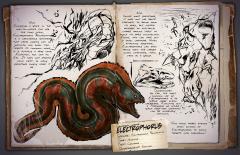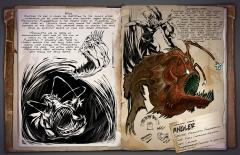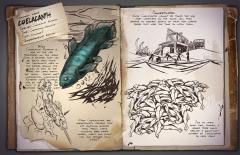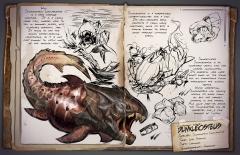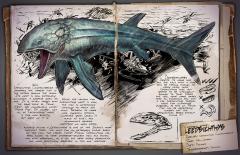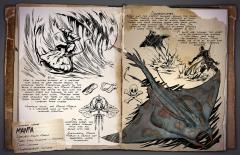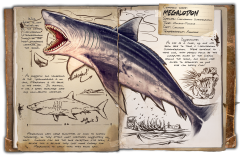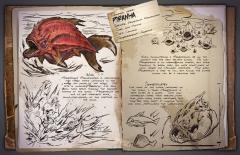Search the Community
Showing results for tags 'fish'.
-

Chauliodus stompagida - The Viperfish - MonstersHunters
MonstersHunters posted a suggestion in Game Suggestions Archive
Originally planned for addition for the Center’s unique geography yet limited amount of diverse or unique fauna as of current. My team and I originally were going to select the Late Cretaceous fish Paravinciguerria, though with limited information. We instead selected another bizarre form of Stomiiformes fish that could experience deep-sea or abyssal gigantism, based on the Viperfish. Now while the Viperfish is a genus of deep-sea fish that exist today in the Holocene, they trace their evolution back to the Late Miocene of around 11 million years ago with extinct species. Common Name: Viperfish Species: Chauliodus stompagida Time: Late Miocene to Holocene Diet: Carnivore Temperament: Patient Tameable: Yes Rideable: Yes Breedable: Yes Torpidity Immune: No^2 2 = Only during the passive taming process can a viperfish be knocked out with narcotics (by hand in passive taming or with a projectile) Taming Method: Passive Preferred Kibble: Superior Preferred Food: Angler Egg Equipment: “Viperfish Saddle” (Level 60- Crafted at either a Smithy or on an Argentavis saddle) Rider Weaponry: Yes Humans Can Carry: No https://www.mbari.org/animal/pacific-viperfish/ Wild “With abyssal gigantism and experiencing mass niche dominance in the undersea depths, the Viperfish, Chauliodus stompagida feeds on small fish, arthropods and mollusks within the dark benthic zones of the ocean. Their bioluminescence is more elaborate than that of the Anglerfish Melanocetus angerlpescum, having a special spine on the frontal dorsal fin that acts as a lure, and multiple photophore organs on its sides. Counter-illuminating with surrounding light levels and the continuous dark environment, Chauliodus unhinge their jaws and sit in wait, watching with their large eyes as a small prey source is attracted to the motion of a small light. With shock absorbing vertebrae, the viperfish lunges forward in an instant, consuming the prey whole”. Domesticated “Being more than 12 times larger than their present day counterparts, C. stompagida is usually used by survivors towards traversing the depths without notice by larger predators, using camouflage and large eyes specialised for low light environments. The viperfish is also used for hunting, with large teeth that prevent the fish from closing its mouth completely, being able to swallow prey up to two thirds its own size and with its hypnotic lure. The viperfish is a perfect example of a deep-sea predator”. - Helena Walker Anatomy While the genus Chauliodus is present today, species such as Chauliodus eximus and Chauliodus testa have been uncovered from digsites, presenting that this genus originates with a presence in the fossil record from the Late Miocene. The first species, Chauliodus eximus was originally described in 1925 by American Ichthyologist David Starr Jordan from stratified material in Southern California, United States. The second species, Chauliodus testa was discovered and described in 2014 by Russian Ichthyologist Mikhail V. Nazarkin from the Kurasi Formation of western Sakhalin Island belonging to Russia. https://pterosaurheresies.wordpress.com/2019/10/17/chauliodus-the-viperfish-enters-the-lrt/ When describing the anatomy of these fish, the genus Chauliodus are bizarre in nature and appearance. Most viperfish feed primarily on lanternfish (myctophids), bristlemouths, krill and deep-sea copepods, but are also known to search surface waters for food during pelagic migrations. These migrations are influenced by temperature, with observations describing that the upper limit of distribution is restricted by temperatures around 12 to 15°C, this affecting vertical habitat and trophodynamics. In warmer or tropical climates, viperfish can exist full time in waters below 400 metres. This form of migratory behaviours is known as diel vertical migration. Viperfish are known to migrate to depths of 400 metres at night, these fish are able to withstand daily temperature changes of up to 7°C, even being able to withstand ranges of 4 to 14.5°C. These forms of migrations have been observed in the western Mediterranean Basin, the Adriatic Sea, the Aegean Sea, the Levant Sea and North African waters. The eyes of Chauliodus viperfish maintain a constant size and proportion throughout the fish’s lifespan, but inside of the eye. Seven specialised rod cells continue to grow and overlap upon one another in the retina, increasing in number with the size of the fish. Rod cells are the photoreceptor cells within the eye that are hypersensitive to light levels, allowing these fish to see more accurately in low light frequencies within the mesopelagic (where only 1% of the sun’s original light reaches below 200 metres) and bathypelagic zones. https://www.deepseawaters.com/sloanes-viperfish.html Unlike other fish, viperfish are not covered in scales, they are instead covered in a thick, slimy, transparent coating of an unknown substance that is layered upon hexagonal pigment patterns. This material on their skin most likely helps with their bioluminescence. Viperfish have photophore organs on their ventral, lateral and ventrolateral sides, designed to both emit light as a form of communication, towards luring prey and even as a form of camouflage in the surrounding depths in order to avoid predators. These bioluminescent organs emit light through adrenergic nervous control with synaptic transmission between the nervous system, but also connect to the fish’s endocrine system. Studies have found that the release of adrenaline (epinephrine) and noradrenaline (norepinephrine) trigger bioluminescence in Sloane’s viperfish. These fish have even evolved these bioluminescent organs to match the surrounding depths and distributions of light, in a form of camouflage known as counter-illumination. When describing breeding and reproduction, viperfish are gonochoristic (have separate male and female individuals in each species of this genus, when compared to other fish that are hermaphrodites) and breed through batch spawning and asynchronous oocyte development in females. Pacific viperfish (Chauliodus macouni) lack swim bladders and instead rely on the use of acidic glycosaminoglycans in their gelatinous tissue which is used as a form of buoyancy. Viperfish are prey to certain species of deep-sea organisms, primarily certain genera of dolphins and sharks. The paleoenvironment of the Middle to Upper Miocene Kurasi Formation that included Chauliodus testa contained a multitude of different fish species, including prehistoric Cetorhinidae basking sharks, Alepisauridae Lancetfish, Oneirodes Dreamer anglerfish, bristlemouths including Cyclothone mukhachevae from surrounding formations alongside Scomber Mackerel fish, Bathylagidae, Microstomatidae and Leuroglossus or Deep-sea smelts, Argentiniformes, ridgeheads such as Scopelogadus and Caridean shrimp. Design, Behaviour and AI https://sfbaymsi.tumblr.com/post/96105059407/the-viperfish-chauliodus-sloani-viperfish-can Chauliodus stompagida would be a species designed for a more opportunistic hunting method. Through the use of a bioluminescent lure at the tip of a spine on the first dorsal fin, the muscles in the spine swing the lure from side to side, simulating a moving prey item from the interpretation/perspectives of marine invertebrates and other deep-sea vertebrates. Dangling this lure usually in front of the fish’s mouth. Using their long, elongated sharp fangs (they are so long that the fish could puncture its own brain with misalignment) coupled with a protruding hinged lower jaw and skull adapted to a wide opening in the mouth, these fish grab and swallow their prey whole, snapping at quick instances that prevent prey from escaping. Their jaws are able to be unhinged and can open their mouths up to 90° and can catch prey that are up to 63% of their own body size. The stomachs of these fish are quite elastic and are designed to contain and digest prey that have been swallowed whole. These details will apply to the fictional species in Ark and its behavioural instincts towards hunting. Chauliodus similar to other deep-sea fish can experience deep-sea gigantism, which can alter their overall size or mass in certain depths in the ocean. In shallow environments, present day viperfish individuals are found to have lesser or smaller masses than those at depths of over 500 metres. This can play into gameplay with smaller individuals being found around the water’s surface, gradually getting larger the deeper the water progresses. With deep-sea specialisation and the principles of deep-sea gigantism, Chauliodus stompagida will be much larger than its present day counterparts, being over 6 feet in length. Their body plan and shape should resemble the below image: https://en.wikipedia.org/wiki/Sloane%27s_viperfish#/media/File:Chauliodus_sloani_Gervais.jpg ------------------------------------------------------------------------------------------------------- Abilities and Advantages - With their unique jaws, viperfish can unhinge their jaws from alignment (with their teeth remaining in place) and can either swallow prey that are around 63% of the fish’s original size, or can use their long canine-like teeth to gouge and pierce the flesh of enemies or predators. This ability which can be activated on its behavioural menu or on command via riding, is known as “Unhinged”. The viperfish can not close its mouth, otherwise it could impale its own eyes or its brain due to the size and length of its teeth. - Viperfish such as Chauliodus macouni or the Pacific Viperfish have evolved specialised vertebrae located at the back of their heads, designed to act as shock absorbers (similar to air bags). This is due to high speed collisions and force in bites with prey items that have resulted in the viperfish adapting to high impacts. - The Chauliodus grants better nocturnal vision to riders and survivors within 3 metres of the fish, due to its rod cell adaptability and specialisation in deep sea habitats. - Animals that are too large to be swallowed whole and are just over the 63% body ratio can gain a debuff known as “Swallowed”. This can trap certain creatures and can cause both damage to the viperfish and the prey organism, until the viperfish lets go of the prey item. - The lure on the top of the Chauliodus can hypnotise aquatic animals as large as a kaprosuchus (includes cnidaria, electrophorus, coelacanths, parakeet fish swarms, anglerfish, sabertooth salmon, megapiranhas, eurypterids, humans and trilobites) but can stun animals such as mantas, ichthyosaurus, carbonemys and sarcosuchus for a limited amount of time (depends on the creature). The hypnosis ability lasts for 30 seconds to a minute depending on the size of the viperfish. - The most important detail and characteristic of the Chauliodus is its size. The deeper the ocean, the larger the viperfish. This means that larger viperfish have stronger bites, sizes, and can swallow large prey, when compared to smaller shallower viperfish that might instead be faster in manoeuvrability rather than in defence, size, health and melee damage. Weaknesses - Viperfish are gill-breathing fish and can not breathe on land as they lack lungs. - Chauliodus stompagida are obligated towards deeper deaths and can experience pressure and temperature problems if they swim past a limit of 250 metres, with larger individuals being limited to around 300 to 350 metres . - Chauliodus are weak against megalodons and basilosaurus. Taming Method: In order to tame a viperfish, a player needs to be hypnotised under its lure and similar to a bloodstalker. The player will be grabbed and held in its jaws, taking small amounts of damage in the process, but being able to consume food items, medical brews and Sanguine Elixir which boosts both taming efficiency and taming progression by 5 to 10%. During this time, the player will give the viperfish either Superior Kibble or Anglerfish Eggs, however. Unlike other passive tames, the Viperfish will hold onto the player as it swims through the water, having to be fed every 2 to 3 minutes depending on its level. During this taming process, the viperfish is no longer torpid immune and can be tranquilised if necessary. Spawning Location: Chauliodus stompagida are primarily found in deep depths of around 300 to 1000 metres below the surface and will hide in darker environments, using their camouflage and bioluminescence to aid in counter-illumination. To give perspective, this would include the Deep Ocean and Oceanic Cliffs on the Island, the Eastern Trench on the Center, the Dark Depths of Genesis Part 1’s Ocean Biome and the Midgard Fjordur oceans. Warmer climates would see Chauliodus spawn closer around 300 to 400 metres when compared to temperate and colder biomes, which would see the opposite effect. Any suggestions and comments please reply below. These are my team's suggestions, so all credit and reference goes to them for the idea (s). Thanks. - MonstersHunters References: https://en.wikipedia.org/wiki/Chauliodus_eximus https://en.wikipedia.org/wiki/Rod_cell https://en.wikipedia.org/wiki/Viperfish https://en.wikipedia.org/wiki/Pacific_viperfish https://en.wikipedia.org/wiki/Sloane%27s_viperfish https://en.wikipedia.org/wiki/Lancetfish https://en.wikipedia.org/wiki/Bulbous_dreamer https://en.wikipedia.org/wiki/Microstomatidae https://en.wikipedia.org/wiki/Deep-sea_smelt https://en.wikipedia.org/wiki/Photophore https://www.mindat.org/taxon-P352793.html https://www.mindat.org/taxon-9528636.html https://link.springer.com/article/10.1134/S0031030120020112 https://www.schweizerbart.de/papers/njgpa/detail/303/100854/A_new_caridean_shrimp_Crustacea_Decapoda_from_the_middle_late_Miocene_of_Sakhalin_Island_Russia https://www.researchgate.net/figure/Gill-rakers-of-basking-sharks-from-Sakhalin-Tertiary-Specimens-ZIN-306p-1-a-and-ZIN_fig1_273777115 https://www.researchgate.net/figure/Miocene-deep-sea-smelts-from-Far-East-Russia-unidentifiable-to-genus-a-Bathylagini_fig3_325533833 https://www.sciencedirect.com/topics/medicine-and-dentistry/adrenergic-system https://www.eopugetsound.org/content/pacific-viperfish-
- underwaterbase
- fish
- (and 6 more)
-
All art made by me! My creature is the Thoracopterus , a giant flying fish. The creature itself in real life wasn't much bigger than a modern flying fish, but this is ark, and the Rhyniognatha is a thing. It is big enough to ride, say Sarco length, and design wise if you have seen avatar 2 with the giant flying fish that they ride, it's lightly (but not entirely) inspired by them. Also, unlike literally every other creature submission, mine is not a 'giga counter but_________' it is unique and has a purpose. Abilities: - It can skim across the top of the water just like real life flying fish, tip of the tail in the water, top half out of water - You can use weaponry on it without having to enter first person mode, as long as you're not underwater - it can launch itself extremely high out of the water into a flight/ glide mix, gliding through the air but also flapping it's 'wings' occasionally to travel up - it can breathe oxygen indefinitely, but requires water every now and then to keep it hydrated, but the hydration does slowly go down, so luckily to now not have to stay near water at all times it has 8 water canteen slots on it's saddle, which fill up it's water meter when it's low, and can be manually refilled by hand, or all automatically refill upon contact with water, as well as it's water meter. - it can 'run' on land at about the speed of a parasaur, if not slower, which is uncanny because it moves on land by sort of shuffling and jumping forward, but to get airborne again it simply just does a leap into the sky and continues gliding - like the griffin, it has a divebomb/ swoop it can do while gliding, and if you dive into deep enough water from a high enough height it can stun nearby creatures - it can shoot water out of it's mouth like some species of fish, to dismount players off birds up to up to the size of an argy, stunning it if it is wild, at the cost of either being in water or using one of it's eight water pouches - it's 'wings' glow, and can produce a glowing dye that is by default white, but when mixed with any other dye becomes a glowing version of that color - immune to jellyfish/ eel shocks - counter shaded. not really an ability, just an adaptation that ocean predators often have for camouflage - like a dolphin, it can echolocate, highlighting all creatures in the area similar to the desmodus, but with further range underwater )because sound travels farther underwater) - weight reduction on raw fish meat by 75%, silica pearls by 25% all dyes by 50% hide and chitin and keratin by 50% angler gel by 25% and metal by 75% - it is not aggro'd by any sea creatures, excluding mosas and plesis So there you go. A midgame mount, good for pve & pvp, that isn't insanely overpowered, relatively fast, actually unique, so it's good for travel and would probably be used regardless of where you are in the game. Also it doesn't fit the description of 'just give _______ a tlc! This is it without any saddles This is the tek saddle (currently updating it to look closer to the new head model) Tek additional abilities: -A charged super bite attack (like shadowmane) -Legs to run mush faster on land, no longer having to lean on it's wings, now at the speed of a deinonychus -A jet to fly significantly faster in the air, and underwater -top and belly armour to take reduced damage on the top and belly, but still taking damage as normal from it's side Dossier- wild Something seems amiss with this creature. It's not just the size or the eerie uncanniness; it's the unsettling feeling that it simply shouldn't be. The anomalies are too pronounced to ignore; one could say the evidence points to genetic manipulation, but by whom and for what purpose, I cannot say. The Thoracopterus, as I've come to call it, defies conventional classification, blurring the lines between land, air, and water with an unsettling ease. This beast possesses an ability akin to that of dolphins, using echolocation to sense and locate anything within its vicinity. A sensory prowess usually reserved for marine life, yet this creature carries it with an unsettling confidence. But the strangeness does not end there. The Thoracopterus is no mere fish, for it can venture onto land and relentlessly pursue its prey. Escaping its pursuit is a futile endeavor; cliffs and parachutes offer no refuge, as it can pursue its quarry in the air with relentless determination. The creature's enigmatic intelligence adds to its eerie nature. It seems to comprehend danger, avoiding projectiles with an unsettling, almost preternatural awareness. Attempting to ward it off may prove only momentarily effective, for once it locks onto a target, it will persist until either the prey or itself meets its end. Moreover, the Thoracopterus possesses an astonishing leaping ability, scaling heights that defy reason, rendering the advantage of higher ground obsolete. Dossier- Domesticated tamed I stand astounded by the audacity of those who dare to tame such an enigmatic beast. The taming process, an underwater rodeo of sorts, is a perilous endeavor where merely holding on is a feat unto itself, given the Thoracopterus' unparalleled speed. Yet, for those intrepid souls who triumph in this endeavor, they will find themselves blessed with the ultimate traveling companion. Tamed, the Thoracopterus showcases its multifaceted nature, becoming an unparalleled asset in both PvE and PvP scenarios. A master of the aquatic realm, it navigates the waters with astonishing speed, becoming a swift and reliable underwater steed for any survivor seeking rapid aquatic exploration. But it doesn't end there. On land, the Thoracopterus runs with an almost inexplicable grace, defying expectations with its ability to move on terra firma. This incredible agility allows it to cover ground like a blur, making it an ideal choice for scouting missions and daring escapes from adversaries. The creature's flight capability elevates its prowess even further. In the face of a daunting confrontation with a formidable player and their powerful dinos, the Thoracopterus offers a unique advantage. With your weapons drawn and securely positioned on its back, you can unleash a torrent of firepower upon your foes, all while maintaining a stable third-person view. Yet, when a swift retreat becomes the need of the hour, the Thoracopterus becomes the ultimate escape artist. Its leaping ability propels it to unimaginable heights, from where it can gracefully glide away, leaving pursuers far below in awe and wonder. Adding to its mystique, this extraordinary creature produces a peculiar glowing dye, which, when mixed with any regular dye, transforms the colours into an eerie luminescence. The resulting spectacle can only be described as otherworldly, adding a touch of the fantastical to any survivor's creations. Proof it's a real extinct creature ^ How it would skim across water ^
-
Species: Rhizodus gigas Time: Carboniferous Diet: Carnivore Size: about 20 meters Sadle unlocks at 78 lvl Stats: 700 health 500 stamina 300 moisture (oxygen) 75 basic damage ??? Speed 600 weight(selica and black pearls weight less in its inventory) About: Rhizodus gigas is giant fish that terrorizes freshwater, sometimes saltwater and even land fauna that got unlucky being near water while Rhizodus is around. Even tho Rhizodus gigas is a fish it can crawl on land to catch its prey, but prey on land is fast so it uses it slimy belly to charge at it and have better chances of catching it. Original Earths Rhizodus was only a Freshwater fish but Rhizodus gigas can also be found in oceans. Abilities: 1. Grab When Rhizodus catches small prey it swallows it whole but when it catches big prey it takes it as deep as possible and drowns it, in fear preys oxygen drains way faster than usuall. If you tame it you can use grab ability to grab your own tames or tribemates and take then underwater without worrying about them drowning cuz Rhizodus will provide them with oxygen. If it grabs another water creature it will start mauling it with its powerfull jaws Deals 70 damage doesnt matter if u grab wild creature or your own tame 2. Tail slap Tail slap stuns small animals in water and does huge knockback + bonebreak(20 sec.) on land. Deals 50 basic damage 3. Charge Charge gives Rhizodus speed boost for 7 seconds and deals 5 basic damage to everything that gets in the way 4. Slide Rhizodus can use its slimy belly to slide on land like a penguin, but can use it only 3 times, if all 3 is used it will have cooldown 10 minutes until you can use it again 5. Fire resistance Slime protects Rhizodus from getting burned or take damage from fire 6. Thick skull Rhizodus will take less damage from being shot/hit in the head Gender dimorphism Males have large payara like teeth to fight and atract females and long snout. Those teeth are large enough to land deadly wounds and cause massive bleeding even to animals bigger than Rhizodus itself. Females have short but wide snout with catfish like teeth to protect their eggs by hiding them in their mouth. Wide mouth suck in multiple of small creatures Taming method: 1. Use repelant and let it swallow you after which it will spit you out and take some torpor(will drop very slowly) and then wait for it to do it again to knock it out, Rhizodus will eat any sort of meat exept for spoiled one but its most favorite is lamb 2. Become Jeremy and use fishing to tame it! 3. Make it swallow something poisonous to make it fall unconcious 4. Make it swallow carbonemis so it will choke and fall unconcious Can farm: Selica pearls, Black pearls, stone and flint Cant shoot from saddle Thanks for art to ArtSaturator on twitter (probably gonna recieve some changes, most likely fins)
-
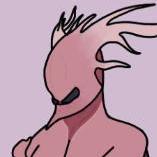
Histionotophorus bassani - The swordsman handfish!
Goredeus posted a suggestion in Creature submission archive
Unfortunately I did not have enough time to write a dossier please forgive me Histionotophorus is a giant handfish native to the shallow coasts on the center. while it has a calm disposition, it will not hesitate to defend itself using its elongated dorsal spine! General Omnivore breedable lays eggs requires a saddle to be ridden Taming Histionotophorus is a passive tame using tuso tentacles as food Abilities Passive Histionotophorus is semi aquatic and can swim through water and walk on land (though much slower) Gains the hydration buff when in water similar to spino Active LMB - Bite Deals low damage and harvests corpses and bushes RMB - Unsheathe dorsal spine Allows Histionotophorus to use its spine attacks SPACEBAR - Toggle climbing Toggles climbing mode when on land and walking mode while swimming LMB (Unsheathed) - Dorsal spine slash Histionotophorus slashes with its dorsal spine dealing a stack of open wound. once 5 stacks is reached the target is dealt a burst of %damage and then are applied armor reduction for a few seconds. If Histionotophorus hits an enemy while mid air they are vaulted upwards Histionotophorus swings slower on land C (unsheathed) - Dash Histionotophorus dashes forward dealing 2 stacks of open wound to enemies in its path If Histionotophorus hits an enemy while mid air they are vaulted upwards Dash lets Histionotophorus jump from the water Dash has less distance when used on land Additional reading https://en.wikipedia.org/wiki/Handfish (info on handfish) https://tb.plazi.org/GgServer/html/2816A22677549657411A1895FBC57E8A (info on Histionotophorus)-
- fish
- semi aquatic
-
(and 1 more)
Tagged with:
-
From the album: Dossiers
Common Name: Electrophorus Species: Electrophorus Beluadomito Time: Holocene Diet: Carnivore Temperament: Reactive Wild: Occupying a space in the low-to-middle end of the food chain, Electrophorus beluadomito is a carnivorous swimmer that feeds mostly off of shellfish and small fish. Despite its common name, it is actually a very long knifefish, and not an eel. It does not provide much meat, so many predators simply leave it be. Unlike most predators, it does not use brute strength to bring down its prey, but instead releases an electrical charge around itself to knock its prey unconscious. Alone, this can take out a small creature. When attacking together, Electrophorus can even bring down the larger ocean lifeforms, then feed as a group. Domesticated: By far, the most common use of Electrophorus is to subdue large ocean creatures. Knocking out a Plesiosaur or other giant deep-sea leviathan can be incredibly difficult, thus many tribes employ small schools of Electrophorusto shock targets into submission! -
From the album: Dossiers
Common Name: Pegomastax Species: Melanocetus Anglerprescum Time: Early Cretaceous-Holocene Diet: Carnivore Temperament: Aggressive to small fry, otherwise skittish! Wild: Whether it’s size is caused by adaptation to the island’s other inhabitants, or by cross-breeding with another larger species, Melanocetus Anglerprescum is the largest form of Anglerfish I’ve ever heard of. Typically found only among the deepest, darkest expanses of the ocean, this creature preys on smaller fish while being an excellent source of food for larger predators. Melanocetus has an array of bioluminescent light pods at the end of stalks on it’s head. Like typical Anglerfish, it primarily uses these to attract smaller fish and trick them into coming close enough for Melanocetus to consume it’s prey. This often makes wild Melanocetus itself relatively easy to spot among the briny depths. Domesticated: Exploring the depths of the ocean can be difficult. The cold, the lack of air, and the shocking absence of light combine to make travel very dangerous. A tamed Anglerfish can use the natural light at the end of it’s stalks to illuminate the depths, making exploration not only safer, but more lucrative. Furthermore, these luminescent nodules can be harvested to create long-lasting organic light emplacements for surface dwellings. -
From the album: Dossiers
Common Name: Coelacanth Species: Coelacanth nutritia Time: Cretaceous-Holocene Diet: Omnivore Temperament: Reactive Wild: Coelacanth nutritia is one of the few creatures on the island with a relative that can be found back home. The Coelacanth lives in the waters around the island, as well as the rivers and lakes within the island. Unlike most Coelacanth, Coelacanth nutritia meat contains less oil and urea. In fact, it is one of the healthier sources of meat on the island. Most Coelacanths are opportunistic feeders that eat anything smaller that itself, likely including baby water snakes, insect and plant life, and perhaps each other? Domesticated: While Coelacanths cannot be tamed the way most creatures on the island can, they provide a possible source of meat for coastal tribes that have the time to catch them.-
- coelacanth
- coel
-
(and 4 more)
Tagged with:
-
From the album: Dossiers
Common Name: Dunkleosteus Species: Dunkleosteus Loricaruptor Time: Late Devonian Diet: Carnivore Temperament: Aggressive Wild: Dunkleosteus Loricaruptor is a very strange creature. It is a fairly large fish, covered head to tail in armored plates, with incredibly powerful jaws. It tends to eat the islands' water-dwelling crustaceans, as it not fast enough to catch most of the smaller fish. Dunkleosteus is a surprisingly combat-oriented for a fish. Its well-armored body protects it from many creatures, while its bite is strong enough to easily crush through chitinous shells. Domesticated: Dunkleosteus is an incredibly useful fish for coastal communities. Its powerful jaws make short work of the stone and oil formations found throughout the oceanic depths. While harvesting, Dunkleosteus can handily defend its rider from all but the largest threats in the waters. And once past its prime, the Dunkleosteus can be harvested for a fair amount of Chitin.-
- dunkleosteus
- fish
-
(and 6 more)
Tagged with:
-
From the album: Dossiers
Common Name: Leedsichthys Species: Leedsichthys Conviviumbrosia Time: Mid-Jurassic Diet: Piscivore Temperament: Defensive Wild: Leedsichthys Conviviumbrosia is probably the largest fish in the waters around the island. Its meant is also extremely succulent, a surprise given its size. It is often traded with the same value as Prime Meat, and colloquially called ‘Prime Fish’. Of course, not all of Leedsichthys’ meat is this high quality but most of it is! While the demand for Leedsichthys meat is high, the fish is notoriously difficult to track and hunt. Between its large size, powerful attacks, incredible speed (when it turns to flee), and humankind’s general ineptitude on open water, actually killing a Leedsichthys is one of the island’s more difficult tasks. The hunt for an extremely elusive breed of the fish, the fabled ‘Great Albino’ Leedsichthys has been known to drive otherwise-sensible men and women mad with obsession, as if all evil were visibly personified and made practically assailable in this one creature. Domesticated: Despite its large size, and the fact that it may well be strong enough to carry heavy loads, Leedsichthys does not appear to be intelligent enough to tame. Nevertheless, some large tribes keep an enormous pen with a few Leedsichthys trapped inside for cultivating purposes, as bits of prime fish can be repeatedly scraped off the gargantuan beast without killing it.-
- leedsichthys
- fish
- (and 7 more)
-
From the album: Dossiers
Common Name: Manta Species: Manta Mobula Time: Early Oligocene - Holocene Diet: Carnivore Temperament: Defensive Wild: Here is another example of a creature that seems to have evolved beyond its historical traits. Everything points to this being a saltwater ray, but Manta Mobula has developed the ability to swim into the island´s rivers and shallows, as well as through the open ocean. Perhaps there were originally two types of ray on the island before, but years of interbreeding combined their lineage. Normally docile, the Manta Mobula is a carnivore only in that it consumes Plankton. Its tail is incredibly sharp, and can pierce through thick hide and armor with ease. Fortunately, Manta Mobula is usually not aggressive, unless encouraged. Domesticated: While not the fastest swimmer around the island, Manta Mobula is the deadliest of small ocean mounts, and can be ridden bare-back. Tribes who value striking power over speed often keep large schools of Manta to ride. Its capability to briefly leap out of water provides it a showy tactic for avoiding combat as well. A quick jab through the heart onto an unsuspecting survivor can easily take them by surprise. Thusly, many tribes use it as an escort for their slower cargo-carrying swimmers. -
From the album: Dossiers
Common Name: Megalodon Species: Carcharodon ultramegalodon Time: Miocene-Pliocene Diet: Carnivore Temperament: Aggressive Wild: Were it not restricted to the waters, Carcharodon ultramegalodon might be the most dangerous creature on the island. As powerful and dangerous as the Tyrannosaurus is on land, Megalodon is its equal in the water. In addition, it has a speed advantage over any non-aquatic creature. Megalodons need large quantities of food to sustain themselves, so they attack most creatures immediately on sight. Smaller fish are the sole exception I've seen; I believe this is because they cost more energy for Megalodons to catch than they would gain. Domesticated: If someone is able to tame this beast, that person would be the undisputed ruler of the oceans around the island and would have access to resources no one can safely find! -
From the album: Dossiers
Common Name: Piranha Species: Megapiranha magnadmorsus Time: Late Miocene Diet: Carnivore Temperament: Aggressive Wild: Megapiranha magnadmorsus is carnivorous fish found fairly commonly in the rivers and ponds of the island. Its bite is incredibly powerful; I've even seen them break through the armored turtles of the island. Megapiranha has one of the strongest bites, pound-for-pound, of any creature on the island. When encountering a Megapiranha, be on the lookout for the rest of the school. No one Megapiranha is an overwhelming threat, but their tendency to swarm prey can make short work of much larger and stronger creatures. Any given Megapiranha is easy to kill, but killing the entire school can be a daunting task. Domesticated: Like some of the other creatures on the island, a tamed Megapiranha is best suited as a guard. Their high metabolism makes them require more food than many other creatures, but they are very adept at hunting their own food, particularly the Coelacanths.-
- aggressive
- carnivore
-
(and 6 more)
Tagged with:



